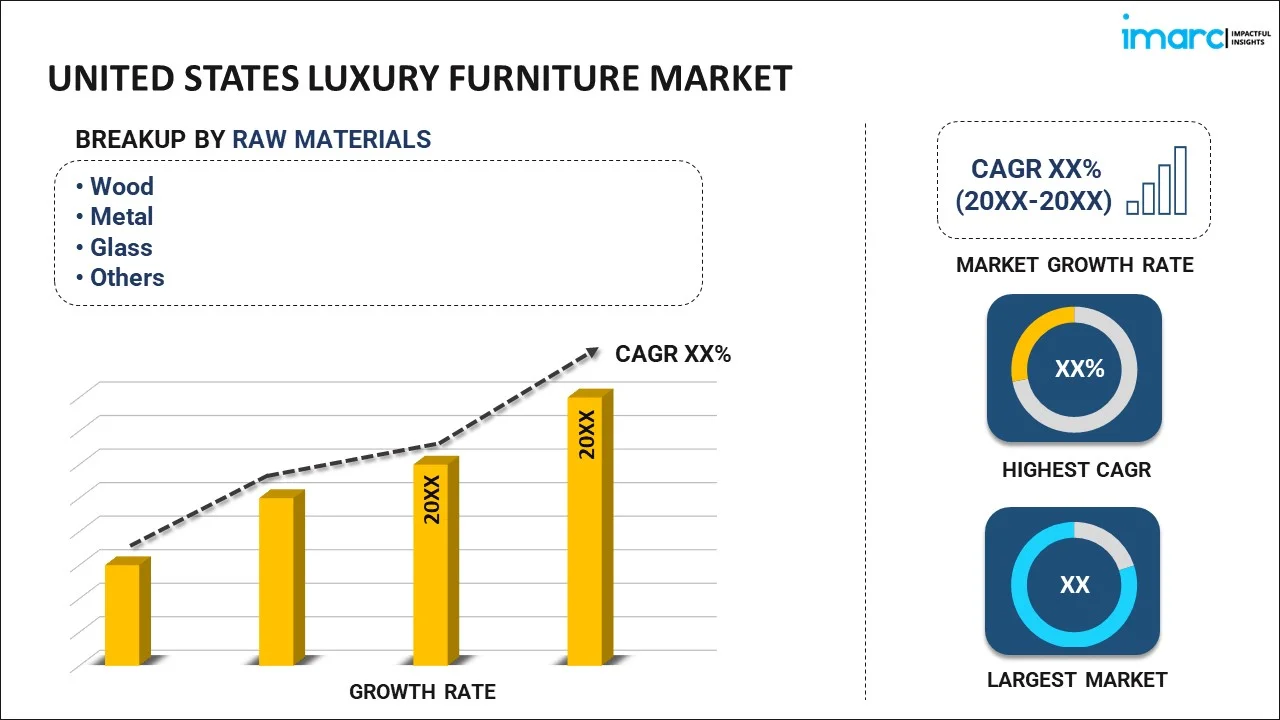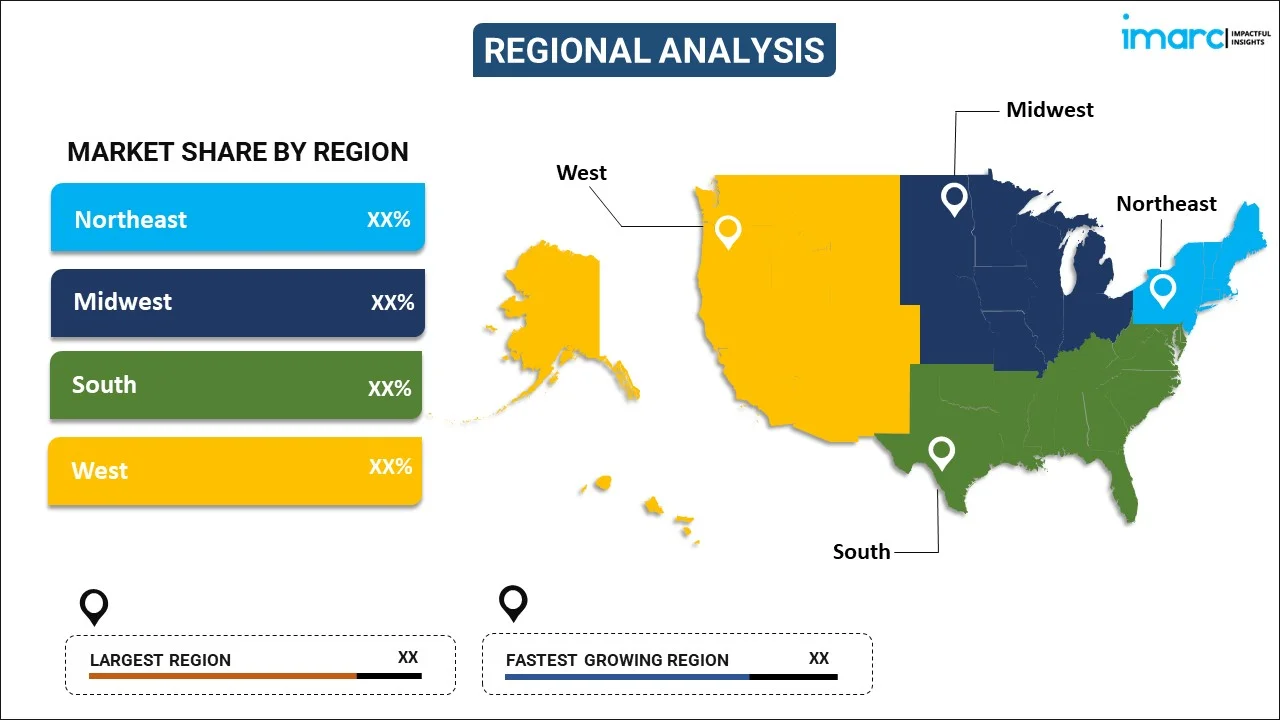
United States Luxury Furniture Market Report by Raw Material (Wood, Metal, Glass, Leather, Plastic, Multiple, and Others), Application (Domestic, Commercial), Distribution Channel (Conventional Furniture Stores, Specialty Stores, Online Retailers, and Others), Design (Modern, Contemporary), and Region 2025-2033
Market Overview:
The United States luxury furniture market size reached USD 6.0 Billion in 2024. Looking forward, IMARC Group expects the market to reach USD 7.3 Billion by 2033, exhibiting a growth rate (CAGR) of 2.2% during 2025-2033. The growing economic prosperity, changing lifestyle preferences, rapid urbanization, rising awareness about design, emerging e-commerce industry and rapid digitalization, increasing sustainability and eco-consciousness, introduction of customization and personalization options, and rising number of renovation and remodeling activities represent some of the key factors driving the market.
|
Report Attribute
|
Key Statistics
|
|---|---|
|
Base Year
|
2024 |
|
Forecast Years
|
2025-2033
|
|
Historical Years
|
2019-2024
|
| Market Size in 2024 | USD 6.0 Billion |
| Market Forecast in 2033 | USD 7.3 Billion |
| Market Growth Rate (2025-2033) | 2.2% |
Luxury furniture is made from high-end materials such as fine woods, top-grade leather, and precious metals. Each piece is crafted by skilled artisans who pay attention to detail, ensuring flawless finishes and intricate embellishments. One distinguishing feature of luxury furniture is its exclusivity. These pieces are often produced in limited quantities, making them highly popular among discerning buyers who appreciate unique, one-of-a-kind items for their homes. Luxury furniture brands are known for their commitment to innovation and creativity, pushing the boundaries of design to create furniture that serves a functional purpose and also makes a bold statement in any living space.
United States Luxury Furniture Market Trends:
Economic prosperity plays a pivotal role in driving the luxury furniture market, as affluent consumers in the United States are more inclined to invest in premium home furnishings. A strong GDP, low unemployment rates, and increased disposable income all contribute to the growth of the market. Additionally, evolving lifestyle preferences have propelled the demand for luxury furniture. With the growing focus on home aesthetics and interior design, consumers are willing to invest in statement pieces that reflect their personal style and status. Luxury furniture caters to this demand by offering exquisite designs and top-tier craftsmanship. Other than this, the ongoing trend of urbanization has led to smaller living spaces in cities, necessitating the need for compact and multifunctional furniture. Luxury furniture manufacturers have responded with innovative, space-saving designs that cater to the urban demographic, thus driving market growth. Besides this, there is an increasing awareness and appreciation of design aesthetics among consumers. The United States has a thriving design culture, and consumers are becoming more discerning about the aesthetics of their homes. This has created a demand for luxury furniture pieces that serve as artistic expressions in addition to functional items. In line with this, the digital revolution has significantly impacted the market. Due to this, consumers now have easy access to a wide range of luxury furniture options online. E-commerce platforms have expanded the reach of the market and made it convenient for consumers to explore and purchase high-end furniture. Furthermore, environmental sustainability has gained prominence in recent years. Luxury furniture brands are responding to this trend by offering eco-friendly and sustainable options, using responsibly sourced materials and adopting green manufacturing processes. This resonates with consumers who prioritize sustainability. Moreover, luxury furniture brands increasingly offer customization options, allowing consumers to tailor their furniture to their specific tastes and requirements. This personalized approach attracts consumers looking for unique and bespoke pieces.
United States Luxury Furniture Market Segmentation:
IMARC Group provides an analysis of the key trends in each segment of the market, along with forecasts at the country level for 2025-2033. Our report has categorized the market based on raw material, application, distribution channel, and design.
Raw Material Insights:

- Wood
- Metal
- Glass
- Leather
- Plastic
- Multiple
- Others
The report has provided a detailed breakup and analysis of the market based on the raw material. This includes wood, metal, glass, leather, plastic, multiple, and others.
Application Insights:
- Domestic
- Living Room and Bedroom
- Kitchen
- Bathroom
- Outdoor
- Lighting
- Commercial
- Office
- Hospitality
- Others
A detailed breakup and analysis of the market based on application have also been provided in the report. This includes domestic (living room and bedroom, kitchen, bathroom, outdoor, and lighting) and commercial (office, hospitality, and others).
Distribution Channel Insights:
- Conventional Furniture Stores
- Specialty Stores
- Online Retailers
- Others
The report has provided a detailed breakup and analysis of the market based on the distribution channel. This includes conventional furniture stores, specialty stores, online retailers, and others.
Design Insights:
- Modern
- Contemporary
A detailed breakup and analysis of the market based on design have also been provided in the report. This includes modern and contemporary.
Regional Insights:

- Northeast
- Midwest
- South
- West
The report has also provided a comprehensive analysis of all the major regional markets, which include the Northeast, Midwest, South, and West.
Competitive Landscape:
The market research report has also provided a comprehensive analysis of the competitive landscape in the market. Competitive analysis such as market structure, key player positioning, top winning strategies, competitive dashboard, and company evaluation quadrant has been covered in the report. Also, detailed profiles of all major companies have been provided.
United States Luxury Furniture Market Report Coverage:
| Report Features | Details |
|---|---|
| Base Year of the Analysis | 2024 |
| Historical Period | 2019-2024 |
| Forecast Period | 2025-2033 |
| Units | Billion USD |
| Scope of the Report | Exploration of Historical and Forecast Trends, Industry Catalysts and Challenges, Segment-Wise Historical and Predictive Market Assessment:
|
| Raw Materials Covered | Wood, Metal, Glass, Leather, Plastic, Multiple, Others |
| Applications Covered |
|
| Distribution Channels Covered | Conventional Furniture Stores, Specialty Stores, Online Retailers, Others |
| Designs Covered | Modern, Contemporary |
| Regions Covered | Northeast, Midwest, South, West |
| Customization Scope | 10% Free Customization |
|
Post-Sale Analyst Support |
10-12 Weeks |
| Delivery Format | PDF and Excel through Email (We can also provide the editable version of the report in PPT/Word format on special request) |
Key Questions Answered in This Report:
- How has the United States luxury furniture market performed so far and how will it perform in the coming years?
- What has been the impact of COVID-19 on the United States luxury furniture market?
- What is the breakup of the United States luxury furniture market on the basis of raw material?
- What is the breakup of the United States luxury furniture market on the basis of application?
- What is the breakup of the United States luxury furniture market on the basis of distribution channel?
- What is the breakup of the United States luxury furniture market on the basis of design?
- What are the various stages in the value chain of the United States luxury furniture market?
- What are the key driving factors and challenges in the United States luxury furniture?
- What is the structure of the United States luxury furniture market and who are the key players?
- What is the degree of competition in the United States luxury furniture market?
Key Benefits for Stakeholders:
- IMARC’s industry report offers a comprehensive quantitative analysis of various market segments, historical and current market trends, market forecasts, and dynamics of the United States luxury furniture market from 2019-2033.
- The research report provides the latest information on the market drivers, challenges, and opportunities in the United States luxury furniture market.
- Porter's five forces analysis assist stakeholders in assessing the impact of new entrants, competitive rivalry, supplier power, buyer power, and the threat of substitution. It helps stakeholders to analyze the level of competition within the United States luxury furniture industry and its attractiveness.
- A competitive landscape allows stakeholders to understand their competitive environment and provides an insight into the current positions of key players in the market.
Need more help?
- Speak to our experienced analysts for insights on the current market scenarios.
- Include additional segments and countries to customize the report as per your requirement.
- Gain an unparalleled competitive advantage in your domain by understanding how to utilize the report and positively impacting your operations and revenue.
- For further assistance, please connect with our analysts.
 Inquire Before Buying
Inquire Before Buying
 Speak to an Analyst
Speak to an Analyst
 Request Brochure
Request Brochure
 Request Customization
Request Customization




.webp)




.webp)












